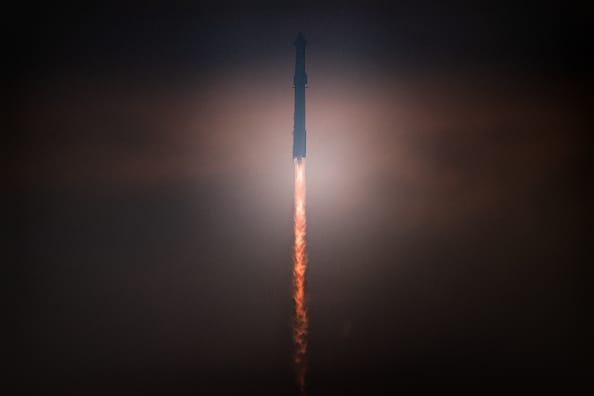
The SpaceX Starship launches during its fourth flight test from Boca Chica beach on June 06, 2024 in Brownsville, Texas.
Brandon Bell | Getty Images
CNBC’s Investing in Space newsletter offers a view into the business of space exploration and privatization, delivered straight to your inbox. CNBC’s Michael Sheetz reports and curates the latest news, investor updates and exclusive interviews on the most important companies reaching new heights. Sign up to receive future editions.
Overview: Starweek
For longtime readers of Investing in Space, you may notice this newsletter is arriving a day later than typical – my apologies for the delay, but I assume many of you (like me) were watching a livestream or two on what was a historic day for spaceflight.
Boeing’s Starliner fulfilled a long-held NASA dream when Butch Wilmore and Suni Williams emerged from the capsule into the ISS. Yes, the docking process got a bit woolly, but the company and agency powered through to reach the space station despite more helium leaks and some testy thrusters. Launches may get the attention, but I know that most involved in the Starliner program only felt relief after the “contact and capture” call confirmed the spacecraft’s arrival.
As Starliner approached its milestone, SpaceX’s Starship thundered off the pad for a fourth time. Each of these monster rocket test flights have gone further than the last, but, for the first time, this one went the distance. Starship checked off more crucial development boxes – all while putting on a show with a nailbiter ending, with a cracked camera peering through the soot at the little flap that could.
The converging milestone moments of the Star-things brings up a question I’ve been asked more than a few times: What’s the difference between Boeing and SpaceX?
Typically I get that question in the context of comparing Starliner with SpaceX’s Dragon, now a veteran of human spaceflight, or the latter company’s dominant run in winning government contracts for launch, exploration missions and more.
Look, I have zero fault tolerance (to borrow words from NASA’s CAPCOM yesterday on ISS’ safety policies) for confusing the stakes of Starliner’s crew and Starship’s fourth test. The simple reality is that one carried the precious cargo of two souls, and the other is hundreds of launches away from matching that.
Boeing’s Starliner capsule is seen while approaching the International Space Station with two NASA astronauts on board on June 6, 2024.
NASA TV
But one aspect of the flights reveal a difference in how the companies approach space: the visuals.
Starliner had classic Space Coast launch views for a couple minutes … and then nothing but a few animations with telemetry data overlays after. For the next 25 hours, we didn’t see Butch or Suni, or witness the view from Starliner’s journey. Why? Apparently it wasn’t a contract requirement beyond “critical mission phases,” and Boeing doesn’t expect to add that feature “for a couple of flights.”
Starship’s launch, on the other hand, was cinematographic and delivered near-continuous onboard live views from dozens of angles through the flight. Millions have now seen the rocket’s Raptors crackle at liftoff past the sunrise, the booster slip back through the atmosphere, the Earth whizzing by below, the rainbow plasma of reentry, and that flap doing its best Terminator 2 impression.
The difference in the spaceflight visuals belies an ethos behind what SpaceX is doing versus Boeing: SpaceX is selling the future, while Boeing’s fulfilling an agreement.
The public interest, judged by the imperfect metric of viral social media posts, also shows that difference. While my recent coverage of the vehicles is 10-to-1 in favor of Starliner, I couldn’t open Instagram, TikTok, X, Reddit or even LinkedIn yesterday without seeing Starship. The few Starliner posts I saw were from official NASA accounts or industry folks celebrating the milestone.
To someone closely following the industry like myself, it’s not lost how staggering of an accomplishment it is for Boeing to safely fly astronauts to the Space Station. After all, in the grand scheme of American human spaceflight history, Starliner’s only the sixth U.S.-built vehicle to carry astronauts into orbit.
But Boeing’s achievement received what amounted to a shrug from the public, while Starship captivated. The difference, from someone working in a TV newsroom, in part comes from valuing the power of a stunning live view.
What’s up
- NASA declines private proposal to reboost aging Hubble telescope: SpaceX, alongside billionaire astronaut Jared Isaacman, signed a study agreement with the agency in September 2022. Despite Hubble continuing to suffer from faulty gyroscopes and shifting into a more limited operating mode, an official said the agency feared “potential risks such as premature loss of science and some technology challenges.” – SpaceNews
- China’s lunar return mission on the way back to Earth: The Chang’e 6 spacecraft gathered samples, unfurled a Chinese flag on the far side of the moon, and then lifted off from the surface and is expected to land on June 25. – The Guardian
- Russian cosmonaut reaches 1,000 total days in space: Oleg Kononenko, currently on his fifth spaceflight, has set a new cumulative space time record for any person. – AP
- Axiom shows progress on lunar spacesuits: The company said it completed testing at SpaceX’s headquarters on how the Axiom Extravehicular Mobility Unit (AxEMU) will be used with parts of Starship. – Axiom
- Inspector General audit finds NASA is too heavy-handed in commercial lunar cargo program, also known as CLPS. The audit found the agency’s “increasingly risk-averse practices and policies” have “resulted in higher costs and delayed delivery schedules.” – NASA OIG
- Slingshot rolls out AI satellite tracking tool alongside DARPA, saying the artificial intelligence system called Agatha will be able to identify “anomalous spacecraft within large satellite constellations.” – Slingshot Aerospace
- SES and Planet perform data relay demo for NASA, in what the companies claim is the first commercial method of relaying data between satellites in multiple orbits. The companies performed the demo for NASA, as the agency is looking for a privately-development replacement for TDRSS (Tracking and Data Relay Satellite System). – Via Satellite
- Rocket Lab’s Electron completes NASA’s PREFIRE launches, with the pair of missions launching within 11 days of each other. PREFIRE (Polar Radiant Energy in the Far-InfraRed Experiment) are climate-focused satellites that will measure heat lost in space from the Earth’s polar regions. – Rocket Lab
- Mega satellite startup K2 test fires thruster, a krypton-powered Hall effect thruster that the company says will use 20 kilowatts of power, making it four times the power of any known Hall effect thruster flown to date. The company is preparing for its first satellite launch later this year. – SpaceNews
- FAA adds Virgin Galactic and Sierra Space to its live flight data tracker, with the companies joining SpaceX as part of the regulator’s Space Data Integrator (SDI). The tool allows for the FAA to more quickly reopen airspace after the launch or reentry of spacecraft. – FAA
Industry maneuvers
- Lockheed orders $375 million worth of rocket launches from Firefly, making a block buy of 25 Alpha rockets for launches through 2029, including a first mission later this year. Firefly did not disclose the contract’s value, but advertises Alpha for $15 million per launch. – Firefly
- Iridium awarded $94 million Space Force contract: The five-year deal will see Iridium use its Enhanced Mobile Satellite Services (EMSS) in support of “critical U.S. government applications.” – Iridium
- BlackSky adds $7 million contract renewal from an unnamed international government customer, with the deal’s length undisclosed as well. – BlackSky
Market movers
- Astra to go private soon, with the company filing updated information on its merger process, and background on how it ended up in this position. The company also disclosed it is relocating its satellite propulsion manufacturing facility, to consolidate at its Alameda, California headquarters. – Astra / SpaceNews
Boldly going
- Sir Peter Beck knighted in New Zealand, with the country naming the Rocket Lab CEO as a “Knight Companion of the New Zealand Order of Merit for services to the aerospace industry.” – Crux
- Jonathan Lunine named Chief Scientist at NASA’s JPL, coming to the agency from Cornell University. – NASA
- Karlton Johnson appointed CEO of the National Space Society, joining the organization in addition to his role as CEO of Delaine, an advisory group. Johnson takes the helm of NSS from previous chief executive Anita Gale, who recently died unexpectedly. – NSS
On the horizon
- June 7: SpaceX’s Falcon 9 launches Starlink satellites from Florida.
- June 8: SpaceX’s Falcon 9 launches Starlink satellites from California.
- June 8: Virgin Galactic’s Unity launches Galactic-07 mission from New Mexico.
- June 12: SpaceX’s Falcon 9 launches Starlink satellites from Florida.
- June 13: NASA spacewalk at the ISS.

